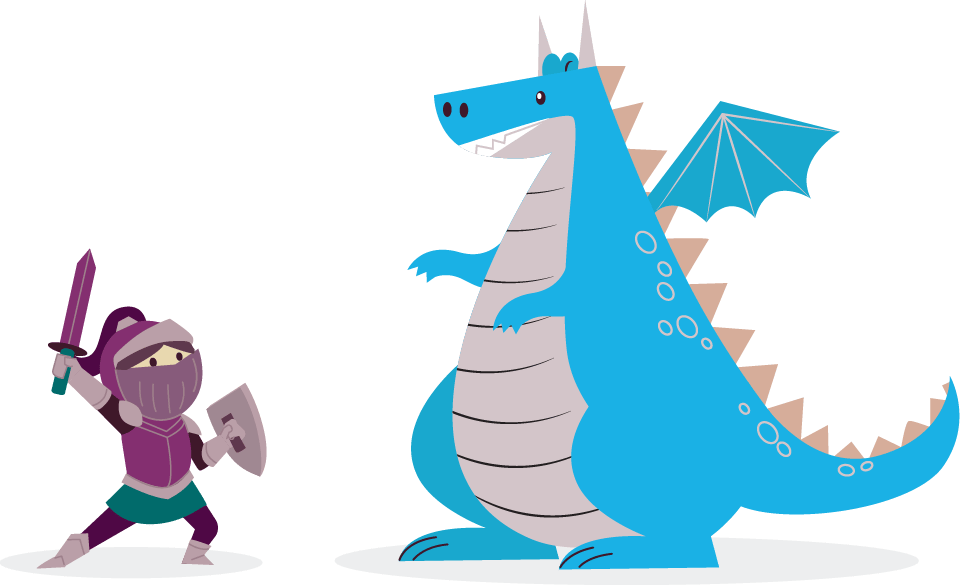
Introduzione
Nel grande mondo della gestione delle relazioni con i clienti (CRM), come si posiziona Odoo nei confronti del gigante Salesforce?
Entrambe le società di software hanno registrato un costante aumento degli utenti sin dalla loro nascita, in quanto sempre più aziende si sono rese conto dei vantaggi derivanti dalla gestione delle operazioni relative ai clienti tramite piattaforme software. Sebbene Salesforce sia un'azienda più vecchia e più grande, con una crescita media annua dei ricavi di circa il 27% dal 2013 [1], Odoo negli ultimi dieci anni ha registrato una crescita costante dei ricavi maggiore del 50% essendo un'azienda nuova e meno conosciuta [2]. La rapida crescita delle due aziende può essere attribuita alla crescente popolarità dei software SaaS che include l'utilizzo di CRM.
Il software CRM fornisce un database centralizzato per le informazioni sui clienti, facilitando la collaborazione tra i team e garantendo l'accuratezza dei dati e dei resoconti. Fornisce inoltre strumenti specializzati per l'automazione delle attività, la generazione di lead e il lead nurturing per aiutare i venditori a trovare e mantenere i clienti, contribuendo a rendere i team di vendita più produttivi in generale.
Un software di gestione dei clienti efficace è fondamentale anche per fornire un servizio clienti eccellente. Oggi i clienti si preoccupano più che mai della capacità di un'azienda di fornire un'esperienza di vendita positiva e di soddisfare tutte le esigenze in modo tempestivo.
Con il servizio clienti sempre più importante e il software CRM che diventa sempre più rilevante per le aziende al fine di organizzare in modo efficace i dati dei clienti e i flussi di vendita, sorge la domanda: quale software CRM scegliere per la propria azienda?
Le due opzioni, Odoo e Salesforce, condividono molte funzionalità CRM, tra cui l'hosting e l'archiviazione in cloud, la gestione delle attività e dei team, i canali di comunicazione con i team e con i clienti (compresa l'integrazione con le e-mail), l'integrazione con il software di vendita, gli strumenti di generazione di lead e i dati, i rapporti e le analisi automatizzati.
Tutte le funzionalità CRM di Odoo sono incluse nell'edizione Standard, mentre alcune delle corrispondenti funzionalità di Salesforce richiedono un aggiornamento (dall'edizione Professional a quella Enterprise) o altri componenti aggiuntivi. Nel complesso, sebbene entrambe le aziende forniscano potenti soluzioni CRM, la struttura dei prezzi di Odoo è più conveniente, rendendola più accessibile alle PMI.
Inoltre, Odoo è un software di pianificazione delle risorse aziendali (ERP) che offre capacità integrate oltre l'obiettivo di un'applicazione a uso unico, come un CRM.
Panoramica CRM
Definizione di CRM
Per gestione delle relazioni con i clienti (CRM) si intendono le pratiche utilizzate dalle aziende per gestire i dati dei clienti e le interazioni con quelli attuali e potenziali. La sigla "CRM" viene comunemente utilizzata in relazione a software CRM, ovvero una tecnologia che aiuta le aziende a organizzare e analizzare le informazioni dei clienti, a comunicare con colleghi e clienti stessi e a gestire i flussi di vendita, tutto questo con lo scopo di migliorare le relazioni.
Il software CRM tiene traccia di ogni interazione che un'azienda ha con un cliente, dai clic sugli annunci e le visite al sito web alle telefonate con i venditori, e rende queste informazioni subito disponibili ai dipendenti, offrendo alle aziende una visione completa a 360 gradi della storia del cliente e consentendo loro di fornire un servizio informato, personalizzato e completo. Il software CRM funge anche da piattaforma per collaborare efficacemente con i colleghi utilizzando le informazioni condivise e fornisce persino strumenti di automazione per aiutare i venditori a svolgere il lavoro più velocemente.
Usare un software CRM: vantaggi
Informazioni centralizzate
I software CRM forniscono un database centralizzato per le informazioni relative ai clienti. Tutti i dipendenti dell'azienda che hanno a che fare con i clienti possono accedere allo stesso database e aggiornare le informazioni in esso contenute secondo le necessità. Nel CRM, i dati sono organizzati in modo che gli utenti possano trovare, aggiungere o modificare facilmente le informazioni.
"I CRM organizzano automaticamente i dati, condividono le interazioni con i clienti e riducono al minimo il rischio di duplicazione del lavoro."
Quando più dipendenti lavorano con un singolo cliente, questi condividono un record unificato di ogni interazione tra il cliente e l'azienda, comprese le e-mail automatiche e le attività di follow-up. Ciò consente a ogni dipendente di fornire un servizio informato senza dover chiedere ai clienti o ai colleghi di spiegare o ripetere le informazioni. Inoltre, il lavoro può continuare anche quando un dipendente è assente.
Grazie all'organizzazione automatica dei dati, alla condivisione delle interazioni con i clienti e alla riduzione del rischio di duplicazione del lavoro con l'utilizzo di un CRM, è possibile ottenere risultati migliori nel servizio clienti. Ciò contribuisce direttamente all'aumento delle vendite (in termini di volume complessivo), all'aumento del valore medio degli ordini (tramite attività di upsell e acquisti ripetuti da parte dei clienti) e all'aumento del valore di vita del cliente (CLV).
Inoltre, la maggior parte dei software CRM organizza le informazioni in report per aiutare le aziende ad analizzare le prestazioni di vendita e marketing. Gli strumenti di reporting del CRM raccolgono automaticamente i dati relativi alle vendite, ai lead e alla progressione delle opportunità attraverso le diverse esperienze dei clienti che un'azienda può offrire. I CRM possono organizzare istantaneamente questi dati in tabelle pivot, grafici e fogli di calcolo e organizzare i dati per data, luogo e molto altro. Poiché i dati provengono direttamente dal database del CRM, è garantito che siano completi e accurati e che ogni team abbia gli stessi dati su cui lavorare. Una raccolta e un reporting dei dati accurati sono particolarmente utili nell'attuale panorama digitale, dove i dati pubblicitari e sulla privacy degli utenti sono diventati sempre più complessi da tracciare, e l'attribuzione dei lead è spesso mista o del tutto assente.
Flussi di lavoro ottimizzati
Another huge benefit of using CRM software is that it automates administrative tasks—everything from following up with customers and scheduling meetings with colleagues, to sending confirmation emails and logging correspondence. Automating these tasks, or otherwise making them very easy to do, frees up employees' time to focus on other tasks and removes the costs and bureaucracy associated with administrative work.
In addition, CRMs are now using artificial intelligence (AI) to automate tasks like lead scoring, which helps salespeople decide which leads to prioritize based on probability scores that pull from a variety of factors. This type of intelligent automation helps people work faster and smarter, as the opportunities that have the highest chance of success are identified and pursued first.
"L'automazione aiuta le persone a lavorare in modo più rapido e intelligente."
Better Customer Relationships
CRM software provides built-in tools that help businesses find new customers and nurture existing relationships. Lead generation technology finds and records the contact information of prospective customers so that businesses can turn those prospects into new business opportunities. For example, Odoo generates leads from visits to a company website. Often, CRMs also integrate with marketing technology to track leads from marketing campaigns and to quickly identify quality prospects.
In addition to lead generation, CRM platforms are also built with lead nurturing tools—such as condition-specific autoresponders that immediately follow up with customers and prospects if they fulfill certain qualifying criteria, or activity scheduling to remind teams to follow up with active leads. Depending on the particular software, CRMs may also provide tools for salespeople to quickly create and send quotations, invoices, and other essential documents to customers—such as quotation templates, draft invoices, and subscription plans
"I CRM sono costruiti con strumenti di generazione e fidelizzazione di lead."
Improved Financial Outcomes
CRM software is statistically proven to benefit businesses financially. In 2014, the average return on investment (ROI) on CRM technology was $8.71 for each dollar spent [3]. And this number has certainly increased since then with continual developments in CRM technology that have made the software more robust and capable—such as embedded analytics and AI-powered features [3].
In addition, CRM applications have been shown to help businesses increase sales by up to 29% and increase sales productivity by up to 34% [4]. With a CRM, salespeople can keep track of every lead, scheduled call, and client customization, and companies that use CRM systems have benefited from a 17% increase in lead conversions and a 16% boost in customer retention [5]. These companies have also seen a 21% improvement in productivity for individual employees [5]. CRM software often integrates with email, VoIP, messaging apps, and other communication systems, and offers numerous automation features, all of which improve productivity. Finally, CRM software provides a centralized and accessible database for company information, and it has been shown that data accessibility shortens the sales cycle by an average of 8-14% [6].
CRM Software Market Analysis
Market Performance and Forecast
CRM software is a popular and fast-growing industry worldwide. The global CRM market size has grown by an average of 11.6% per year between 2017 and 2022 [7]. It is projected to grow from $79.4 billion in 2023 to $131.9 billion by 2028, at a compound annual growth rate (CAGR) of 10.7% during the forecast period [8].
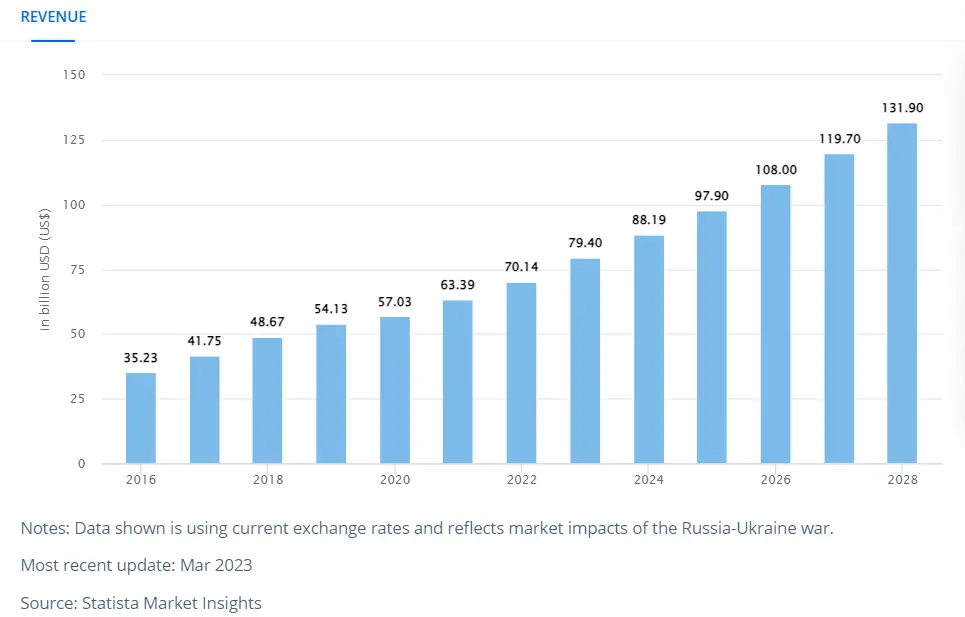
In 2021, it was estimated that over 91% of companies with more than 11 employees were using CRM systems [9].
Market Catalysts
A main factor driving the steady increase in the adoption of CRM software is the rising importance of customer satisfaction. In 2021, it was estimated that over 65% of buyers had higher expectations for customer service than they did 3-5 years prior [10]. For instance, 71% of customers expect a business to share information between employees so the customer does not need to repeat themselves [11]. 78% of consumers said that good customer service is fundamental to earning their business and loyalty, and 90% said they are willing to spend more money with companies that provide personalized customer services [11]. Given the rise in customer expectations and the clear financial benefits of providing good customer service, businesses are prioritizing and investing in their customer service for growth and long-term success. CRM software is the key tool that helps businesses provide informed and personalized services to their customers.
Another catalyst of the CRM market is businesses gaining customers [12]. As businesses grow, they have more and more customers to manage, and a CRM becomes increasingly vital for storing large amounts of information and providing quality customer service. CRM software makes it easy for businesses to scale as they grow their customer base.
"Il software CRM è lo strumento chiave che aiuta le aziende a fornire servizi aggiornati e personalizzati ai propri clienti."
Odoo vs. Salesforce
Sfondo
Salesforce is a long-standing CRM software and the current global leader (by market share) in the CRM applications market. Founded in 1999 in San Francisco, California, with the goal of being "A World-Class Internet Company for Sales Force Automation," Salesforce quickly grew into one of the world's leading companies for sales management software. The company offers a number of integrated apps called "Clouds" (e.g. Sales Cloud, Marketing Cloud) that offer certain features according to a business's needs, as well as apps specifically for AI integrations (e.g. Mulesoft, Einstein), and additional apps that function outside of the Salesforce platform (e.g. Slack, Tableau). Salesforce is known for its cloud-based data storage and AI-driven features.
Comparatively, Odoo is smaller in size, newer, and less renowned than Salesforce. But Odoo is often the choice for small and medium-sized businesses (SMBs) that want the advantages of business management software at an affordable cost. Founded in 2005 in Wallonia, Belgium, with the goal to "lead the enterprise management market with a fully open source software," Odoo makes its software code available online for free, making it very easy for software developers around the world to customize their own Odoo platforms and develop marketplace apps that expand Odoo's capabilities.
"Mentre Salesforce è, nello specifico, un CRM, Odoo è un gestionale che copre un'ampia gamma di bisogni aziendali."
Odoo also aims to fulfill a wide range of operational needs—not just CRM for sales teams. In fact, Odoo is an enterprise resource planning (ERP) software, meaning it supports the needs of an entire business, so that every department in the company can use the same integrated platform and draw from the same database through a variety of interconnected applications. Odoo offers over 50 in-house apps, including CRM, Sales, Marketing, Manufacturing, Inventory, Accounting, Website, Human Resources, and much more. In this way, Odoo goes beyond the 360-degree view provided by traditional CRMs to offer an even more comprehensive view of a business's entire operations.
So while Salesforce is specifically a CRM—with a focus on managing customer relations, sales, and marketing in particular—Odoo is an ERP to manage a wider range of business needs, which includes a fully-featured and integrated CRM. While Salesforce offers popular CRM add-ons—such as marketing and e-commerce—for additional costs, Odoo offers those applications and more (even those unrelated to CRM, such as Inventory and Accounting) for no additional cost. Ultimately, Odoo and Salesforce share similar CRM functionality and user interface options (with some key differences), but Odoo offers capabilities beyond CRM.
In addition, Odoo's open-source business model and accessible pricing structure make it more affordable than Salesforce.
Salesforce
Salesforce's Sales Cloud application, which is a direct comparison to Odoo's CRM and Sales applications, is available in 4 editions: Starter, Professional, Enterprise, and Unlimited.

Salesforce is available in four editions, which are all billed annually:
- Starter
- Includes basic CRM, sales, and email marketing services
- For small teams only
- 25 $ per utente, al mese
- Professional
- Includes a more advanced CRM suite
- For any size team
- 80 $ per utente, al mese
- Enterprise
- Includes a customizable version of the CRM with more automated features
- 165 $ per utente, al mese
- Unlimited
- Includes the advanced CRM suite with automation, built-in AI, and developer support
- 330 $ per utente, al mese
Depending on the edition, various in-house add-ons are available to augment the Sales Cloud for additional monthly costs. These include specific tools for CPQ (configure, price, quote), billing, and marketing, as well as AI features like Einstein. These add-ons range in price anywhere from a few dollars per user per month to thousands of dollars per month.
Contrastingly, Odoo is available in 3 editions: One App Free, Standard, and Custom.
+ di 150k
utenti paganti
+ di 7k
app (in AppExchange)
+ di 630
rivenditori
+ di 56k
dipendenti
Odoo
Odoo includes every app with its entire range of features and integrations in the Standard version. This includes all built-in integrations with external providers—such as WhatsApp for messaging customers, Stripe for accepting payments, and FedEx for making deliveries—as well as all AI and automation features.

- One App Free
- Includes 1 Odoo application for free, forever
- For unlimited users
- 0 $ per utente, al mese
- Standard
- Includes all in-house Odoo apps (including CRM and Sales)
- 24,90 $ per utente, al mese
- Custom
- Includes all in-house Odoo apps plus customizations, multiple companies, and external API
- 37,40 $ per utente, al mese
+ di 12 milioni
di utenti mensili
+ di 44k
app
+ di 5k
partner
+ di 3,6k
dipendenti
Confronto delle funzionalità
The following section compares the key CRM features of Odoo Standard edition ($24.90/user/month) and Salesforce Professional edition ($80/user/month). This only includes the features of Odoo's CRM app and the apps directly related to CRM, not those that cover other business needs that are also included in Odoo Standard edition.
While Odoo and Salesforce share many of the same CRM capabilities, Salesforce is missing a number of specific features that Odoo has already built in. There are often options for third-party integrations that lend Salesforce those capabilities—however, each third-party add-on typically comes with a separate cost.
Information Storage
Odoo
Salesforce
Cloud-Based Data Storage
Contact Database
Linked Contacts
Contact enrichment
*
Customer List
Product Catalogue
Note interne
Customizable Form Fields
*In-app purchases required
Task Management
Odoo
Salesforce
Customizable Pipeline
Kanban Pipeline
Drag-and-Drop Opportunities in Kanban Pipeline
Activity Scheduling
Activity Triggering
Activity Reminders
Activity Calendar
Leads List
Category Tags
Priority Tags
Predictive Lead Scoring
*
Manual Lead Scoring
*Salesforce Enterprise edition required
Team Management
Odoo
Salesforce
Salesperson Profiles
Sales Teams
Team Pipelines
*
Team Calendars
Sharing Availability
Lead Assignment (Automatic)
Lead Assignment (Manual)
Gamification
*
*Salesforce Enterprise edition required
Customer Communication
Odoo
Salesforce
Conversation History (Chatter)
Direct Messaging/Live Chat
**
Email from Opportunity Page
E-mail di conferma
*
Deliver Documents by Email
**
Email Templates
Document Preview
*
Online Customer Portal
**
VoIP
Integrazione WhatsApp
*Salesforce Enterprise edition required
**Additional Salesforce services required
Lead Generation
Odoo
Salesforce
Leads from Website Visits
Leads from Contact Forms
Leads from Campaign Ads
Leads from Incoming Emails
Leads from Event Registrations
Leads from Appointment Bookings
**
Lead Mining
*
**
Lead Enrichment
*
**
*In-app purchases required
**Salesforce Enterprise edition required
Vendite
Odoo
Salesforce
Quotation Builder
Quotation Templates
Import/Exports Sales Orders
*
Upselling and Cross-Selling
*
Optional Products
*
E-Signature on Quotations
Pagamenti online
**
Invoice Management from Sales Orders
Delivery Status Visible on Orders
**
Scheduled Delivery Dates
Carte regalo
e-Wallet
Coupons
Promotional Programs
Price Rounding
Listini prezzo
**
Multiple Prices per Product
**
*In-app purchases required
**Salesforce Enterprise edition required
Reporting
Odoo
Salesforce
Marketing Campaign Tracking
Lead Source Tracking
Reasons for Lost Opportunities
Resoconti personalizzabili
Dashboard personalizzabili
Customizable KPIs
Analytics
*
Order and Invoicing Analysis
Forecast Report
Download as Excel File
Import Spreadsheets
Live Spreadsheets
*
Multiple Graph Options
Tabella pivot dimensioni multiple
*Additional Salesforce services required
Configurazione
Odoo
Salesforce
Utenti multipli
Different Languages
Paesi supportati
+ di 80
+ di 100
Multiple Currencies
Multiple Taxes
Different Types of Access Rights
*
API Access
*
**
*Odoo Custom edition required
*Salesforce Enterprise edition required
Integrazioni
Odoo
Salesforce
In-House Apps
+ di 50
+ di 10
App terze parti
+ di 10k
+ di 7k
Gmail
Outlook
Amazon
**
eBay
**
Mail Couriers (FedEx, DHL, etc.)
*
Payment Acquirers (Stripe, etc.)
*Salesforce Enterprise edition required
**Salesforce Enterprise edition required + additional services required
Usabilità
Odoo
Salesforce
Interfaccia web completa
App mobile
App Android
App iPhone
Interfaccia utente
Odoo and Salesforce provide much of the same information and options on their respective user interfaces (UIs). But while Salesforce maintains a predominantly blue theme, Odoo uses color to categorize and differentiate information on the page.
Kanban Pipeline
Salesforce
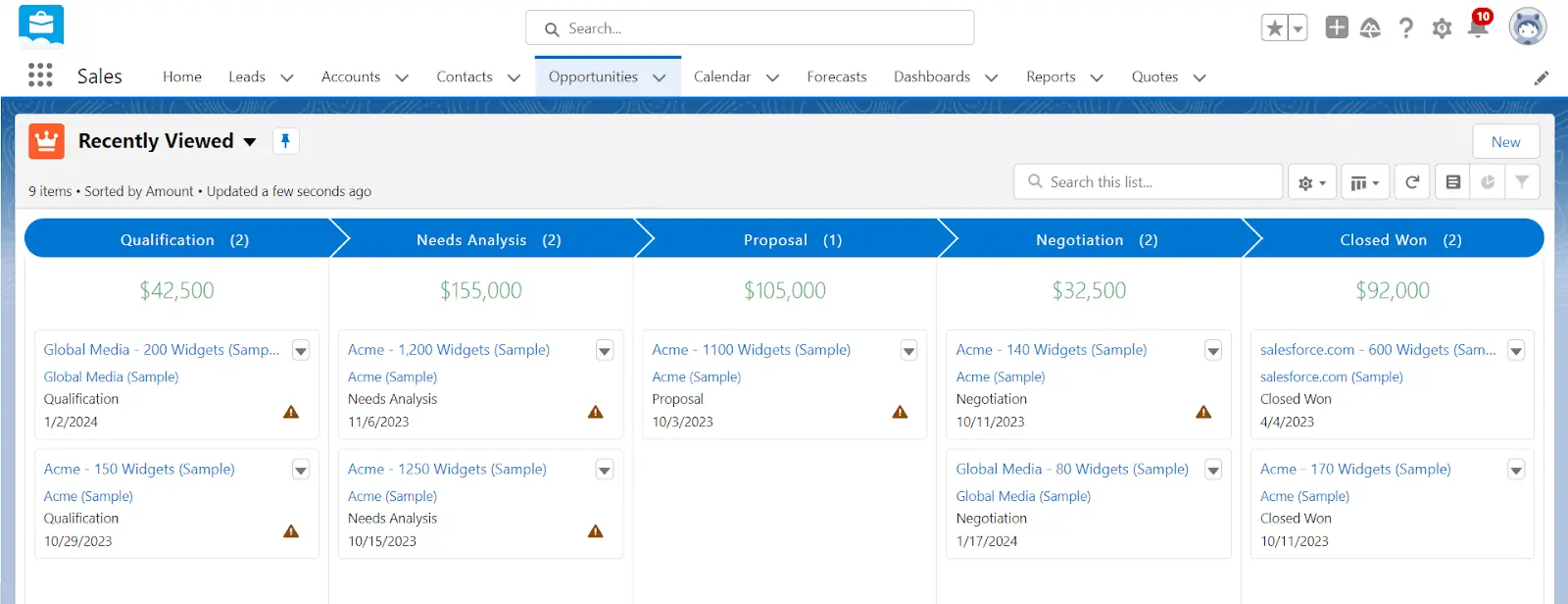
Odoo
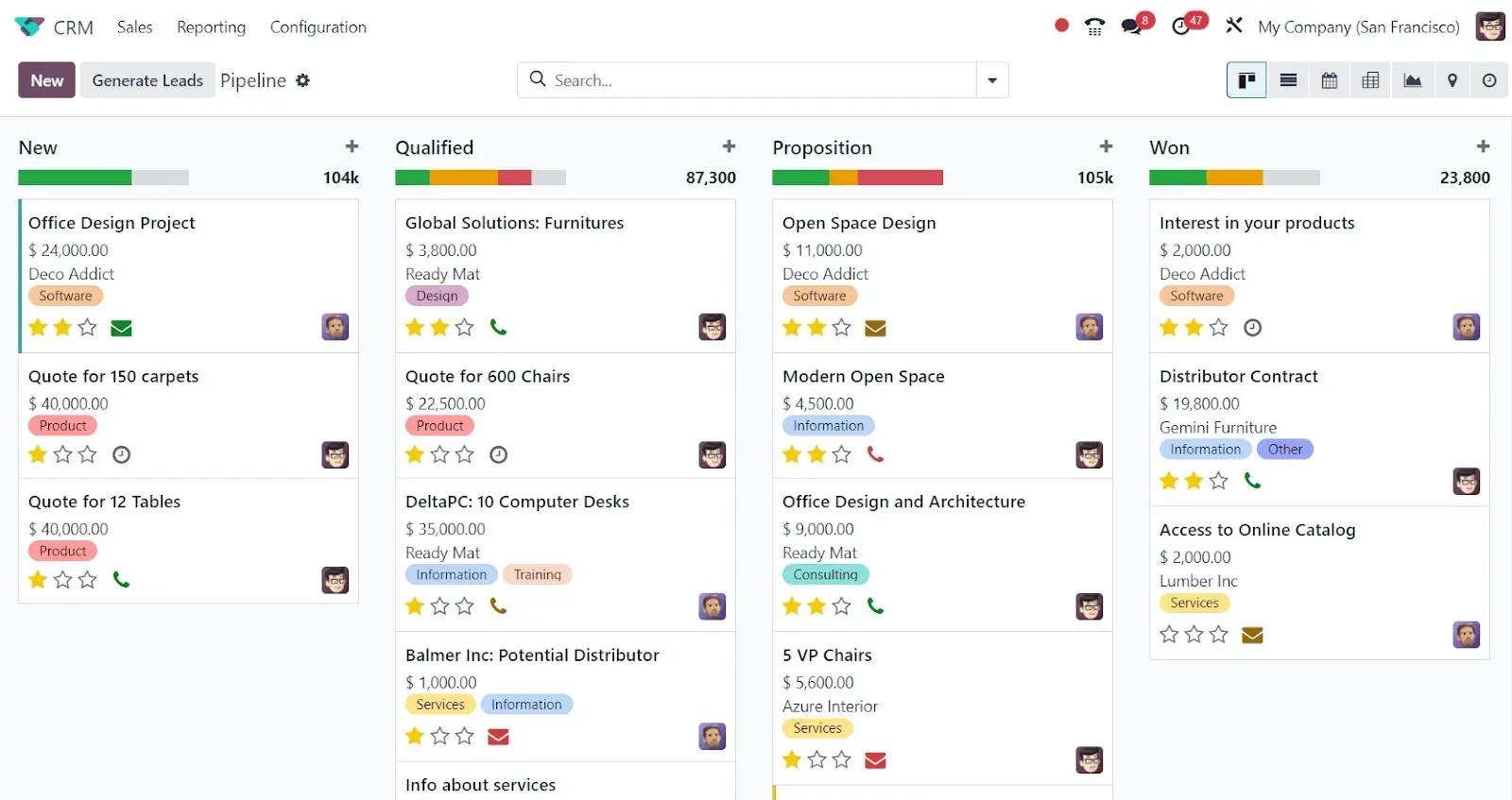
Opportunity Page
Salesforce
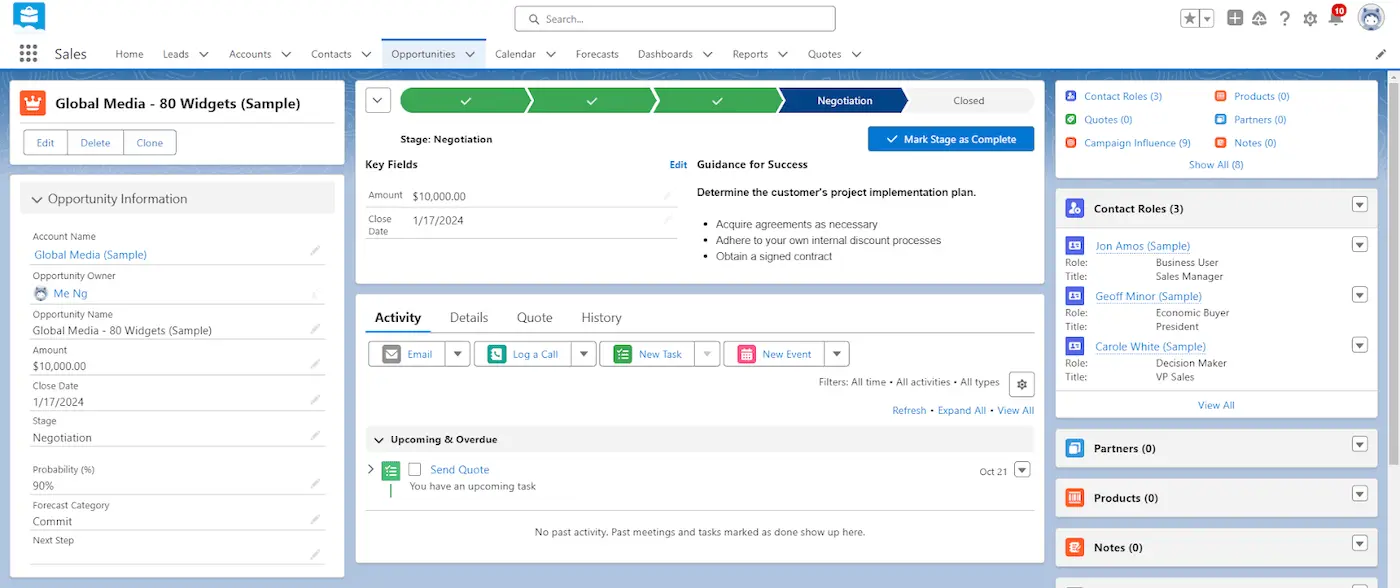
Odoo

Sales Pipeline Report
Salesforce
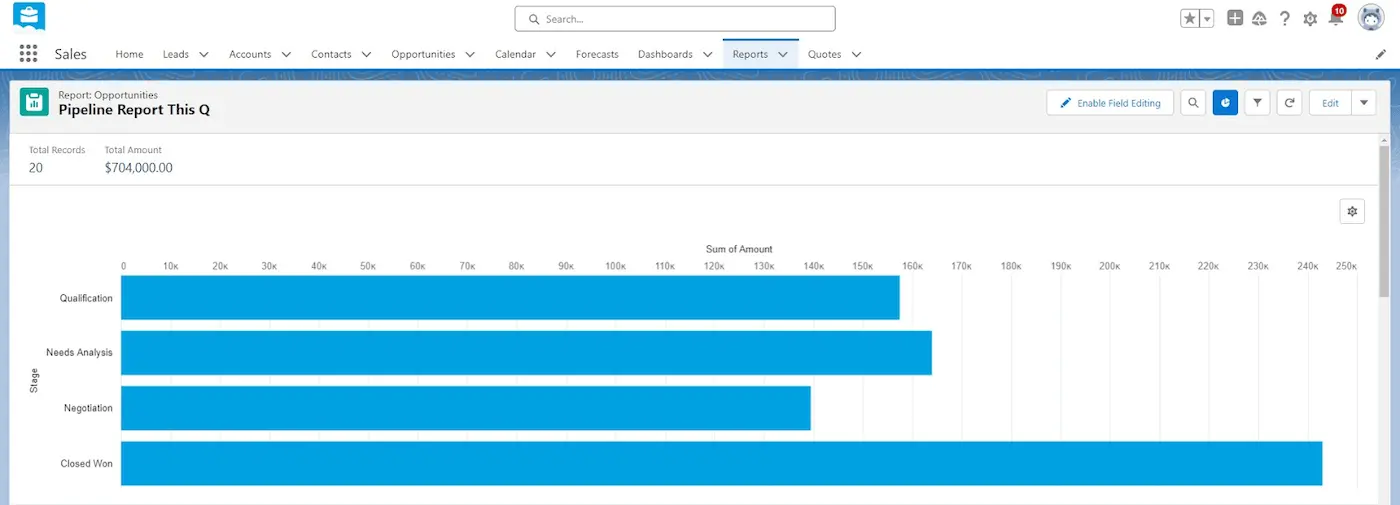
Odoo

Google Trends
Ricerca prodotti

Brand Name Search
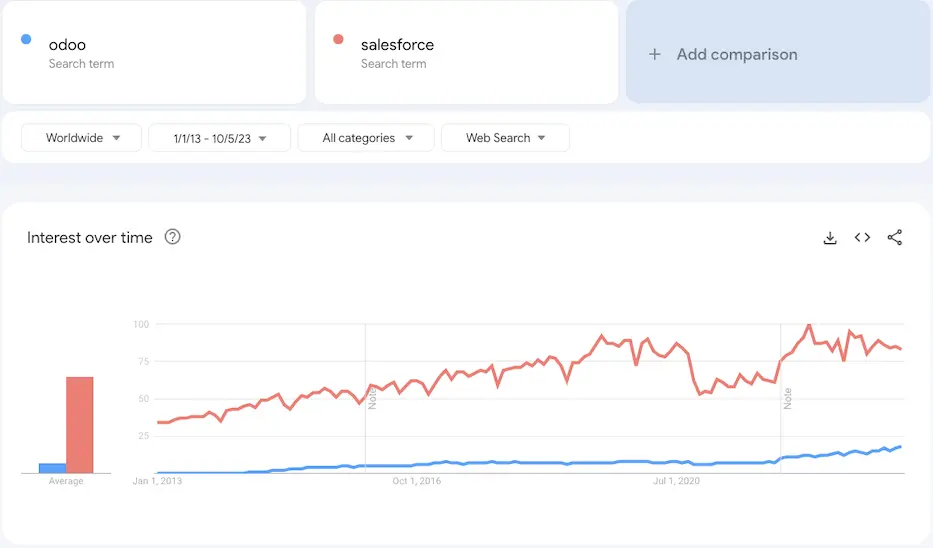
Conclusion
CRM software is an essential tool for any business that wishes to offer a unified sales and marketing database for sales teams. It is proven to help businesses improve their sales outcomes, such as lead conversion rate, along with other valuable revenue-generating metrics, such as customer retention and customer lifetime value. CRM systems provide a centralized database for information, which leads to higher customer retention because teams beyond the initial sales team can access information about the entire customer journey, add to it, and benefit from a centralized view of everything that happens after the sale has been won. CRMs also drive employee productivity with automated actions to speed up workflow, as well as lead nurturing tools to foster personalized customer relationships.
Despite Salesforce being the dominant competitor, the space for CRM software is still a rapidly growing market. As customer service becomes more important to buyers, it also becomes more important for businesses to prioritize in order to grow and retain happy customers. CRM software is a proven tool to help businesses create smoother, easier workflows for employees based on shared customer information, resulting in positive customer interactions at every step of the sales process. Naturally, more and more businesses are opting to use CRM software for their day-to-day business needs.
As far as choosing the right CRM for your company, both Odoo and Salesforce provide excellent tools for organizing information, managing teams, communicating with customers, finding leads, making sales, and analyzing data. Both software systems also have a vast marketplace of custom apps, add-ons, and integrations (although these often come with additional costs). From a CRM perspective, the two software systems offer similar capabilities and user experience, with Odoo's pricing structure making it more affordable than Salesforce.
However, Salesforce is a sales-focused CRM, while Odoo is an ERP. For no additional cost, Odoo offers capabilities far beyond CRM that still work in sync with the CRM app. Businesses can track their entire sales flow through Odoo, providing personalized customer experiences not only through the initial sale, but also through payment, support, delivery, and follow-up. Odoo's marketing apps provide metrics on which campaigns are driving not just sales but profitable customer relationships, taking into account payment history, support needs, and more. Other departments can leverage this insight, so the supply chain and product development teams drive decisions based on customer demand. Odoo CRM also syncs with the Events and Website apps to generate leads from online appointments, event registrations, and website contact pages.
Overall, while Odoo and Salesforce offer similar CRM features, Odoo's capabilities reach beyond CRM to cover the comprehensive operations of an entire business.
This whitepaper was compiled by Odoo Inc. We did our best to make it objective and fair. If you find a mistake or a missing feature, please report it to growth@mail.odoo.com and we will update this document. Our goal is to have a continuously updated comparison of the main competitors to be as accurate as possible.
References
- [1] Salesforce Revenue. Stock Analysis.
- [2] (2021, April 20). Odoo Records Unstoppable Growth. PRNewswire.
- [3] (2014, June). CRM Pays Back $8.71 For Every Dollar Spent. Nucleus Research.
- [4] Howard, Margot. (2023, August 21). 17 CRM stats that sales professionals need to know. Nutshell.
- [5] Karr, Douglas. (2023, September 7). CRM Statistics: The Uses, Benefits & Challenges of Customer Relationship Management Platforms. Martech Zone.
- [6] (2015, August 11). Data accessibility for sales teams shortens the sales cycle. Nucleus Research.
- [7] (2023, November 15). CRM System Providers in the US - Market Size (2005-2029). IBIS World.
- [8] Customer Relationship Management Software - Worldwide. Statista.
- [9] Customer Relationship Management (CRM) Market Size, Share & COVID-19 Impact Analysis, By Component (Software and Services), By Deployment (On-Premises and Cloud), By Enterprise Size (Large Enterprises and SMEs), By Application (Marketing and Sales Automation, Customer Management, Lead Generation & Customer Retention, Customer Support and Contact Center, CRM Analytics, and Social Media Management), By Vertical (BFSI, Manufacturing, IT & Telecommunications, Retail & Consumer Goods, Government, Healthcare, Transportation and Logistics, and Others), and Regional Forecasts, 2023-2030. Fortune Business Insights.
- [10] The Netomi Pulse Report State of Customer Service in 2021. Netomi.
- [11] (2023, May 30). 2023 Customer Service Statistics. 123 Form Builder.
- [12] (2023, January). CRM Software Global Market Report 2023. The Business Research Company.
